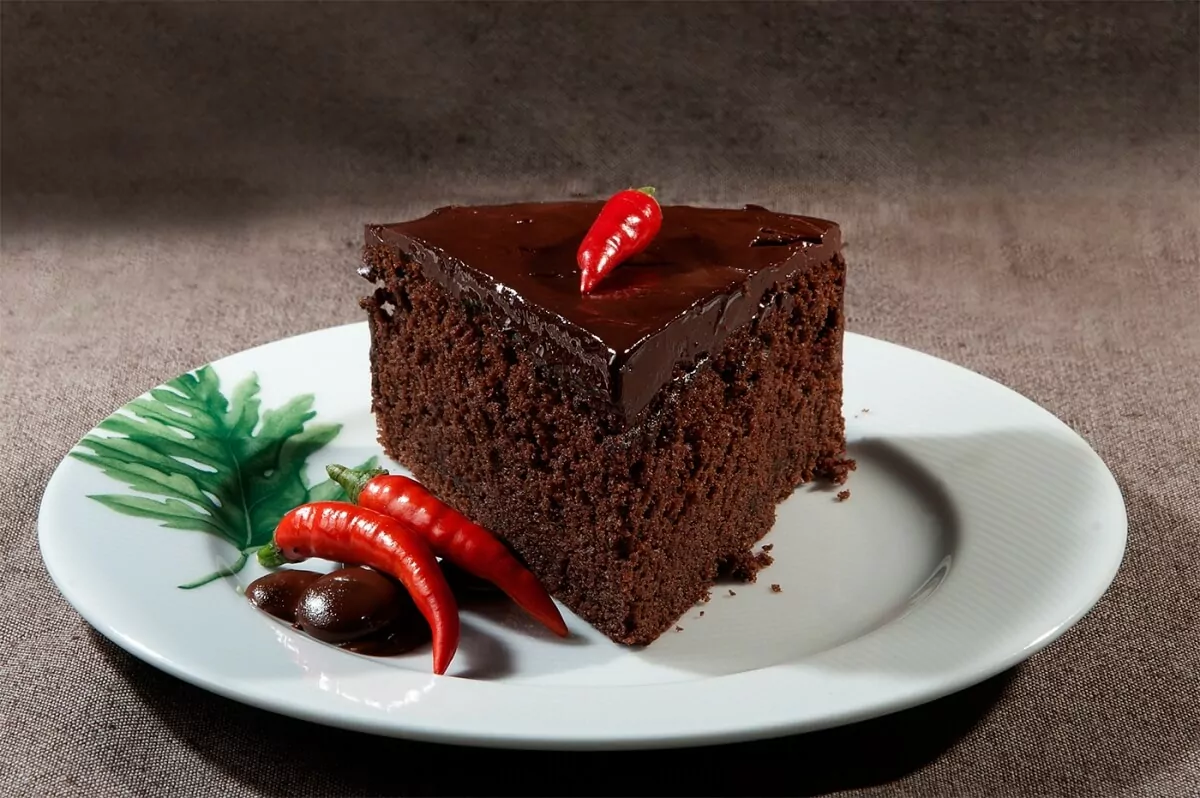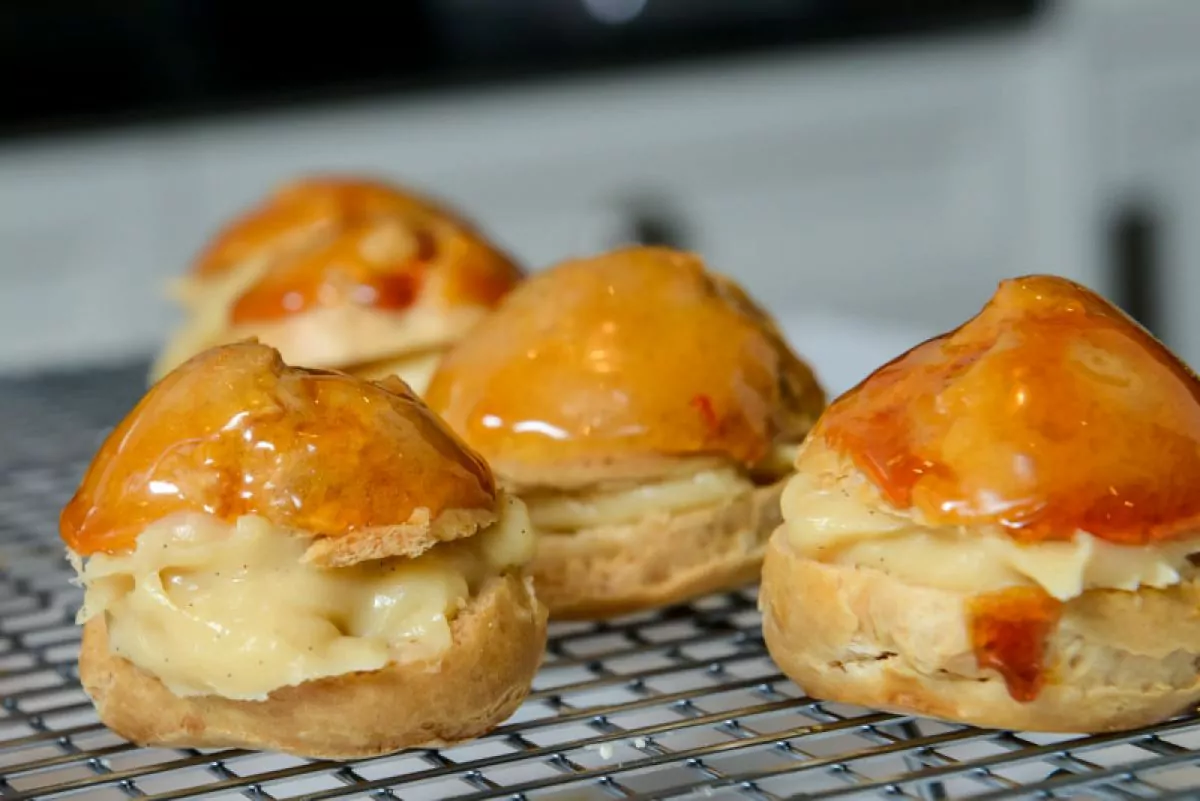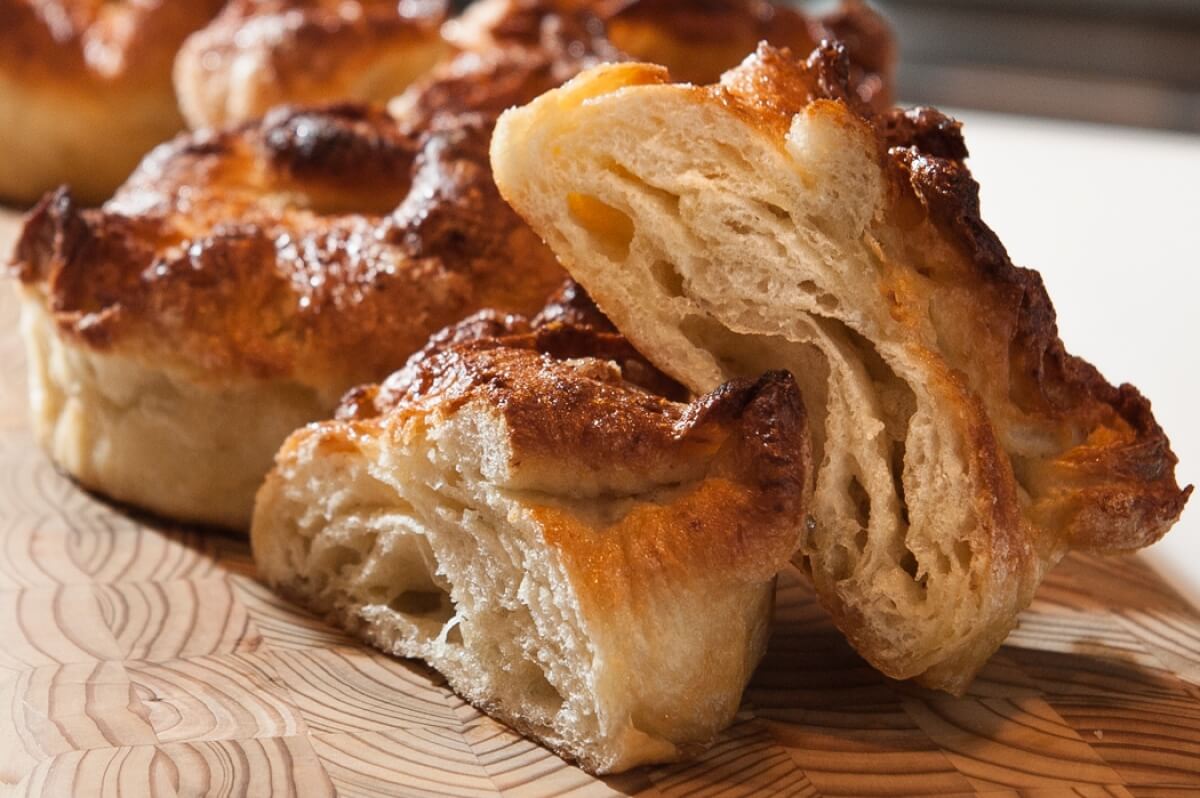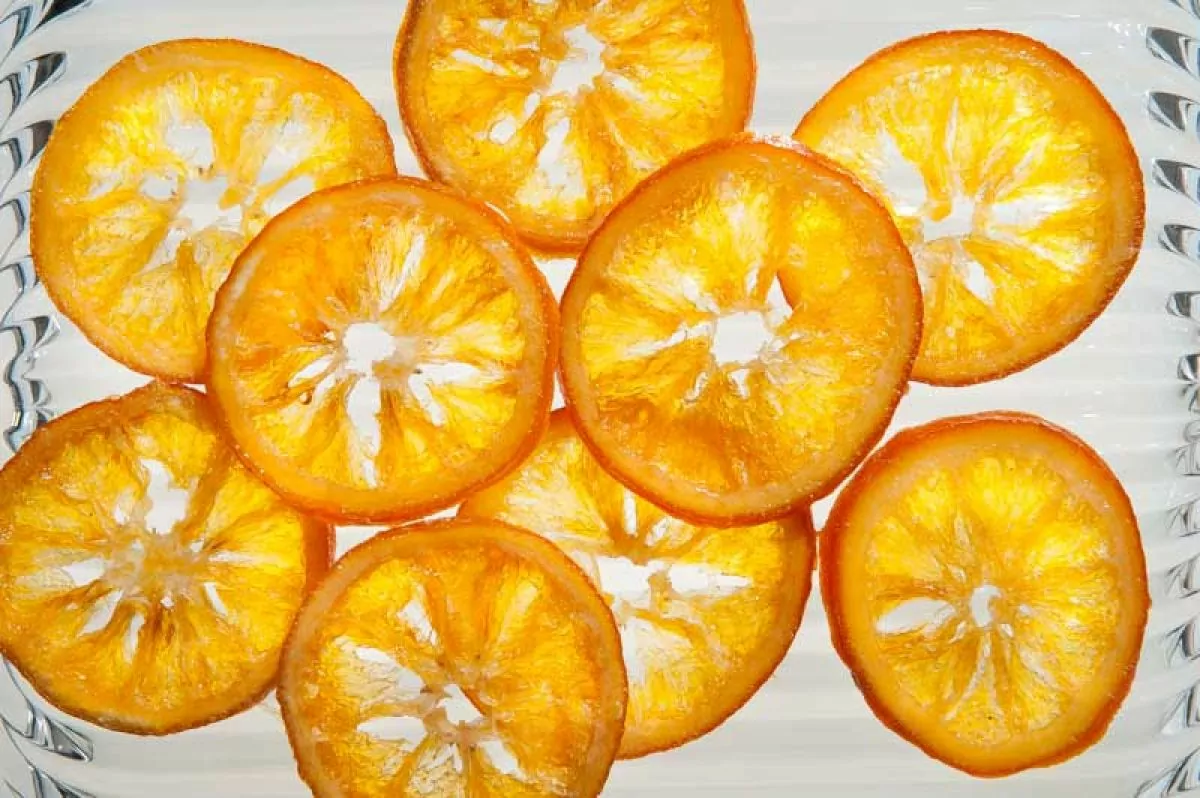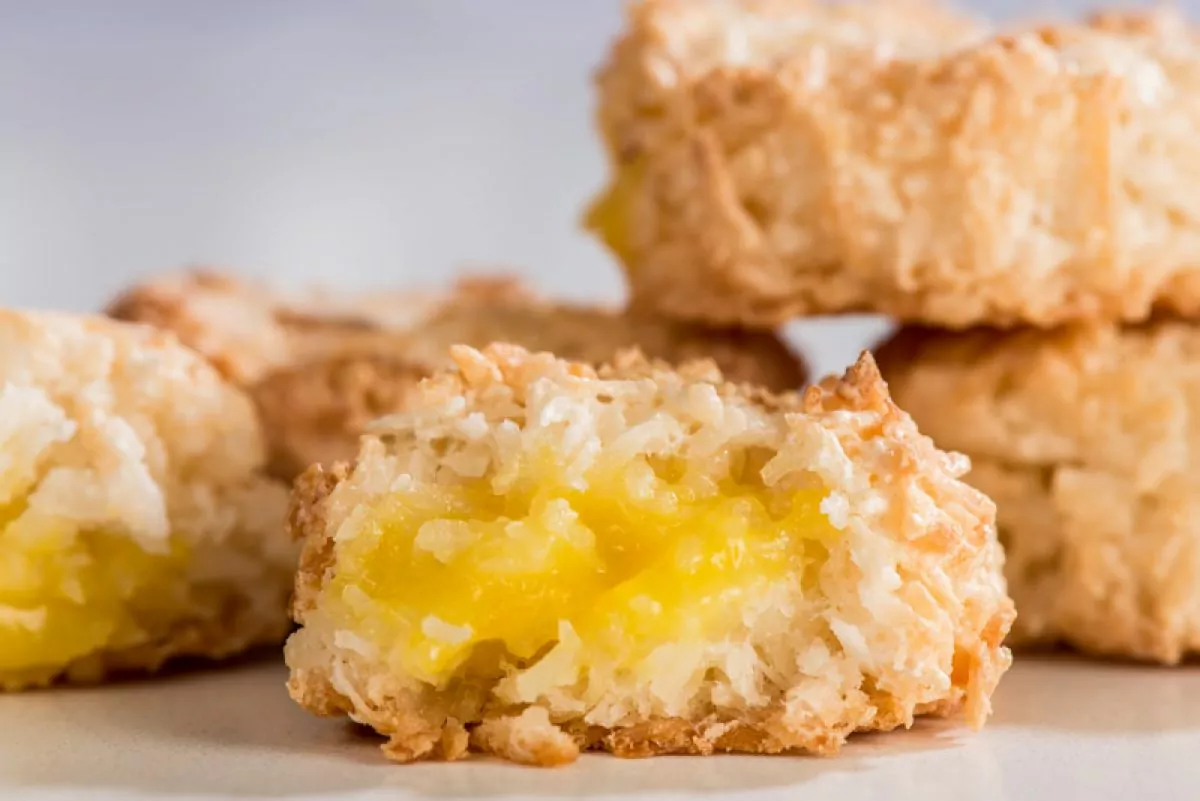
Lemon Macaroons – Gluten-Free
April 2, 2017
For decades, the Coconut Macaroon has been a blank canvas for taste and tradition. For instance, the Dominicans add ginger and cinnamon. In India, they include cashews. In the Philippines, raisins. In Spain, they prefer hazelnuts and honey. Inspired by the traditions of Puerto Rico where they add puckery lemon zest to their macaroons, The Finer Cookie offers new traditions for your Easter and Passover season. Pipe lemon custard into your egg-shaped macaroon, then “crack” it open. The yolk’s on you when the lemon dribbles and the children giggle. They’re fun to mix and bake, and easy to eat. Gluten free too.
Many thanks to Eileen at Baking Sense for the inspiration for this post. She is an expert baker with a terrific website. See the original post.
The Finer Cookie is a participant in the Amazon Services LLC Associates Program, an affiliate advertising program designed to provide a means for websites to earn advertising fees by advertising and linking to amazon.com. This post contains affiliate links, which means The Finer Cookie will receive a small commission if you make a purchase using this link. This modest income helps support the website.
Ingredients
Coconut Macaroon Ingredients
- 3.5 cups 396 grams 14 ounces shredded unsweetened coconut
- (3) or 1/3 cup (3) 86 grams 3 ounces egg whites
- 1/3 cup 85 grams 3 ounces granulated sugar
- 1 teaspoon 1 teaspoon 1 teaspoon pure vanilla extract
- 1 pinch 1 pinch 1 pinch salt
Lemon Custard
- 3/4 sheet silver leaf gelatin 3/4 sheet (2 grams) .07 ounces (3/4 sheet) silver leaf gelatin or 1 1/2 teaspoon powdered gelatine
- 2 eggs 2 (100 grams) 3.5 ounces eggs eggs
- 1 1 (18 grams) .60 ounces (1) egg yolk
- 1/2 cup 99 grams 3.5 ounces granulated white sugar
- 1/3 cup 108 grams 6.25 ounces lemon juice (juice of 1-2 lemons)
- 10 tablespoons 140 grams 5 ounces unsalted butter, room temperature
- zest zest zest of 2 lemons

Instructions
Mise en Place the Lemon Custard
- Soften silver leaf gelatin in cold water for about 10 minutes.
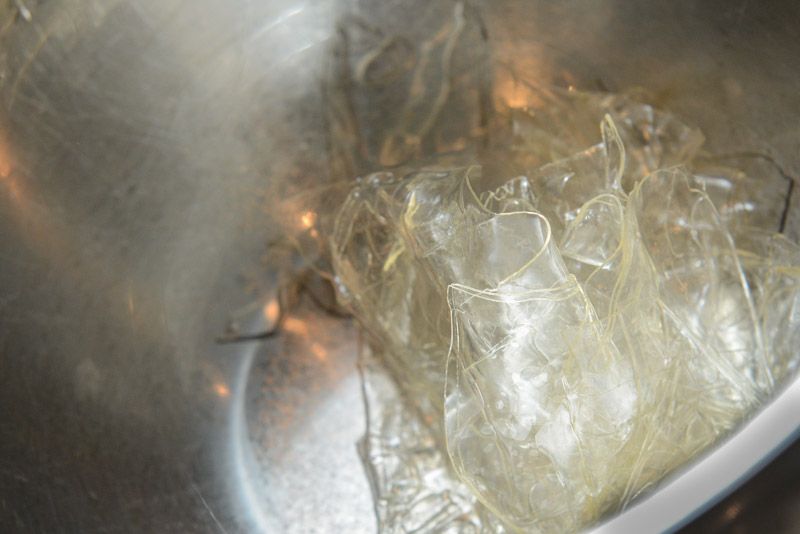
- Alternately, sprinkle the powdered gelatine over 1 tablespoon cold water. Let it bloom for about 10 minutes.
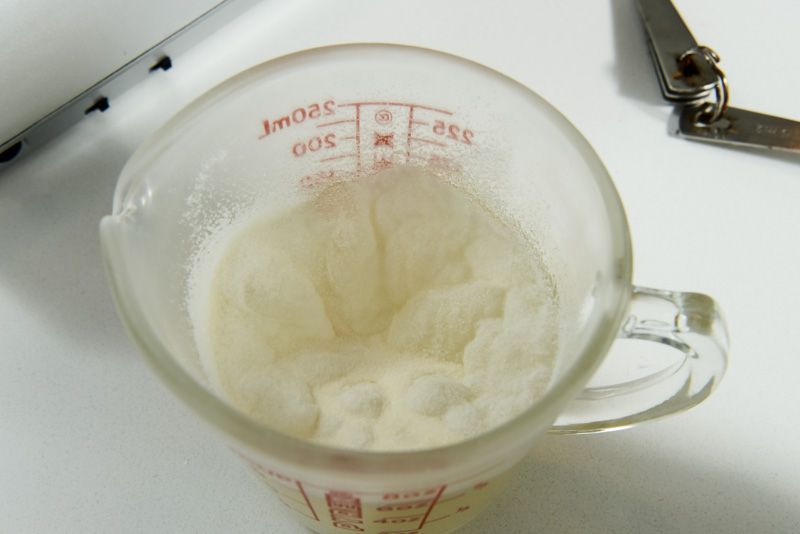
- Crack the eggs and egg yolk into a small bowl. Keep the eggs and sugar separate until your ready to make the lemon curd. The minute you combine the eggs and sugar, the egg will begin to coagulate and reduce its thickening properties. Read more about handling eggs. Visit The Finer Cookie’s post on How to Separate Eggs.
- Measure the sugar into a small saucepan and set aside.
- First zest the lemons with a microplaner, then juice them. Set aside the zest and juice separately. For a complete discussion on zesting citrus, see The Finer Cookie’s post How to Zest Citrus.
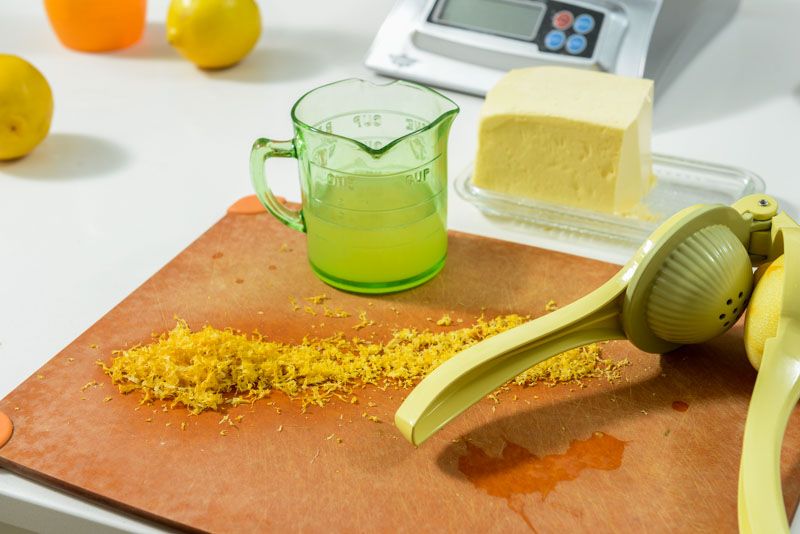
- Measure the butter and set aside.
- Set out your candy thermometer.
Make the Lemon Custard
- Whisk together the egg and sugar until completely homogenous.
- Slowly pour the lemon juice into the sugar and egg mixture.
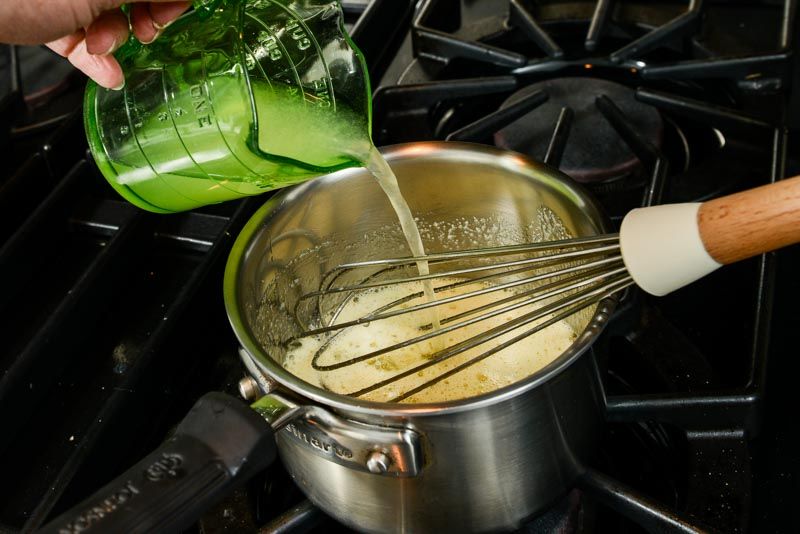
- Set it over medium heat, stirring constantly with a flat edge spatula. The idea is to keep all the ingredients suspended and keep them from settling on the bottom of the pan. This will cause your curd to have lumps.
- Stir until the mixture thickens and reaches 170F to 175F. The egg will be thoroughly cooked through at this temperature. In the absence of a thermometer, the curd will become very thick and will leave a path on the spatula.
- Drop in the sheet of softened gelatine. Alternately, scoop in the bloomed powdered gelatine. Stir until completely melted.
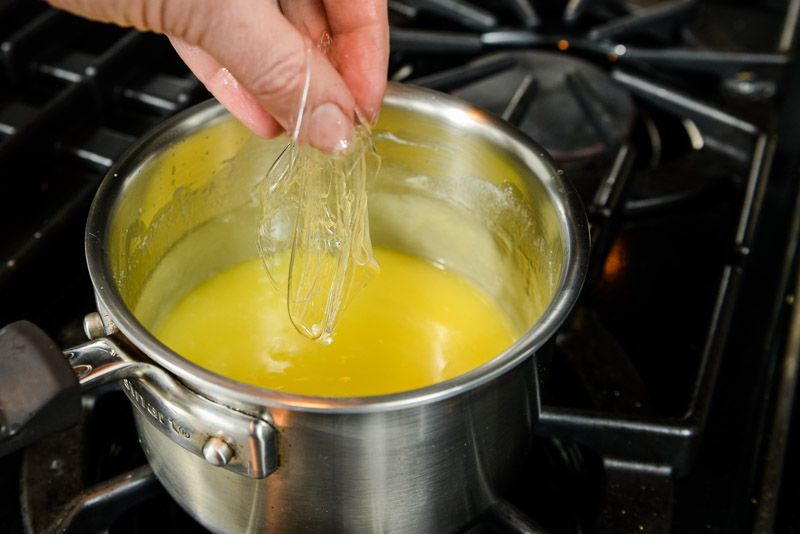
- Add the butter and melt slowly.
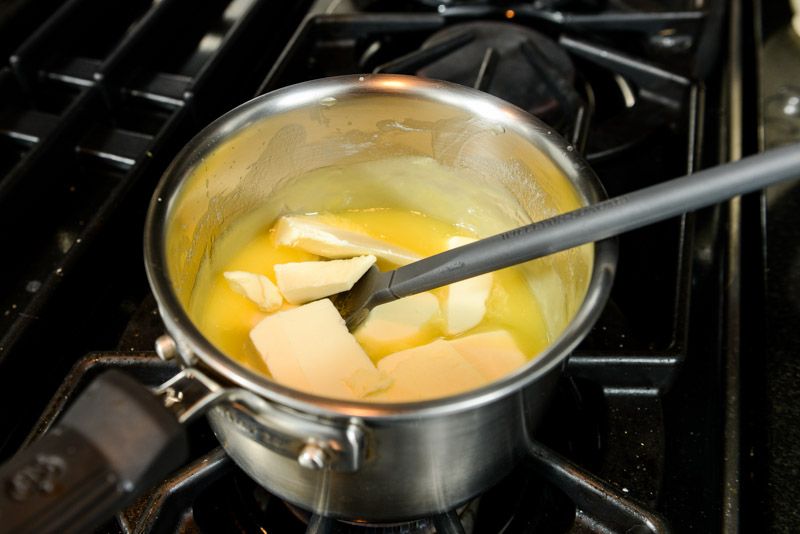
- Strain the lemon curd through a fine mesh strainer.
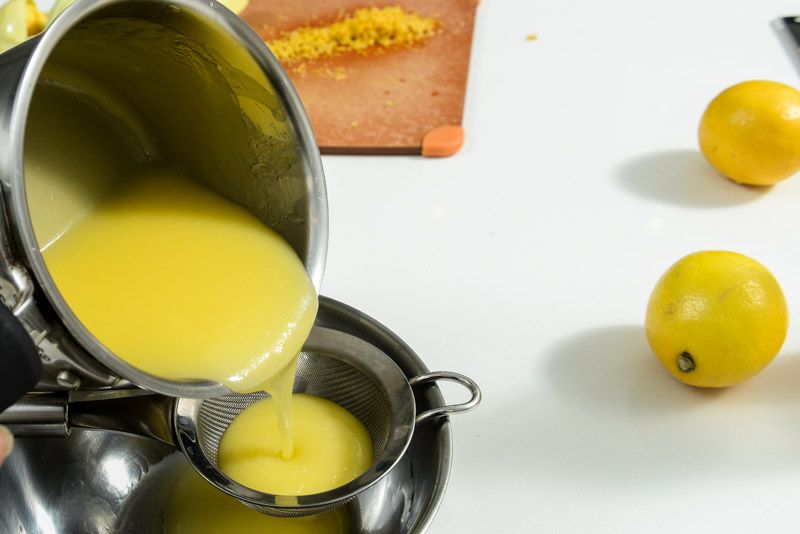
- Add the lemon zest and stir.
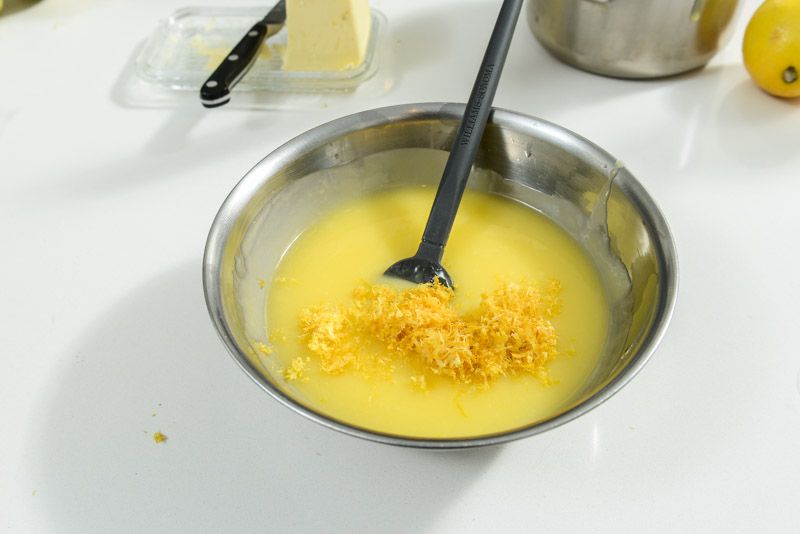
Mise en Place the Coconut Macaroon
- What is mise en place and how could it benefit you? See The Finer Cookie’s post How to Mise en Place.
- Preheat the oven to 350F.
- Line two baking trays with parchment paper or a baking sheet.
- Separate the eggs and place the room temperature egg whites into a bowl of a stand mixer or a hand mixer. For a complete discussion on separating eggs, visit The Finer Cookie’s post on How to Separate Eggs.
- Weigh or measure the sugar into a small bowl and set aside.
- Set the salt and vanilla next to the mixer.
- Measure the coconut into a wide mouth bowl for easier folding.
- Preheat oven to 350F.
Mix the Cookies
- In a stand mixer or with a hand mixer, whip the egg whites to firm peak meringue. See The Finer Cookie’s post on How to Meringue.
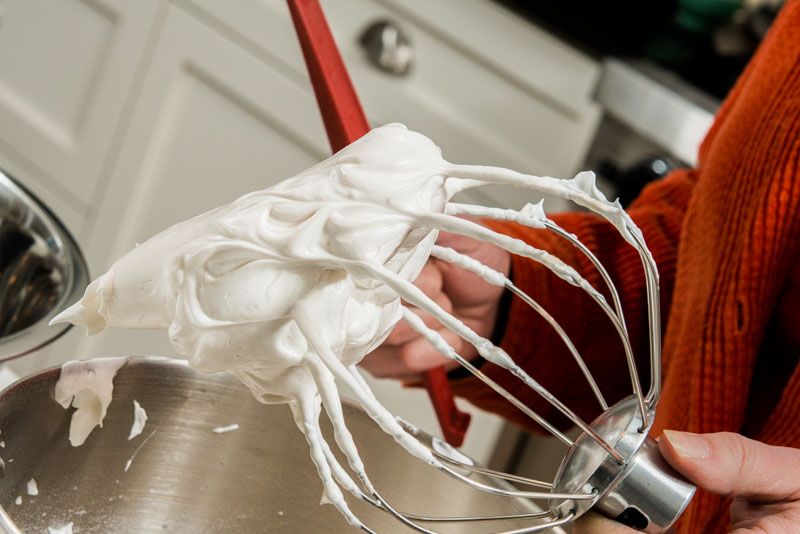
- Gradually add the sugar and whip until incorporated.
- Add the salt and vanilla to the egg whites and transfer the meringue to a bowl with a wide mouth bowl.
- Gradually add the coconut in two additions. Fold in well.
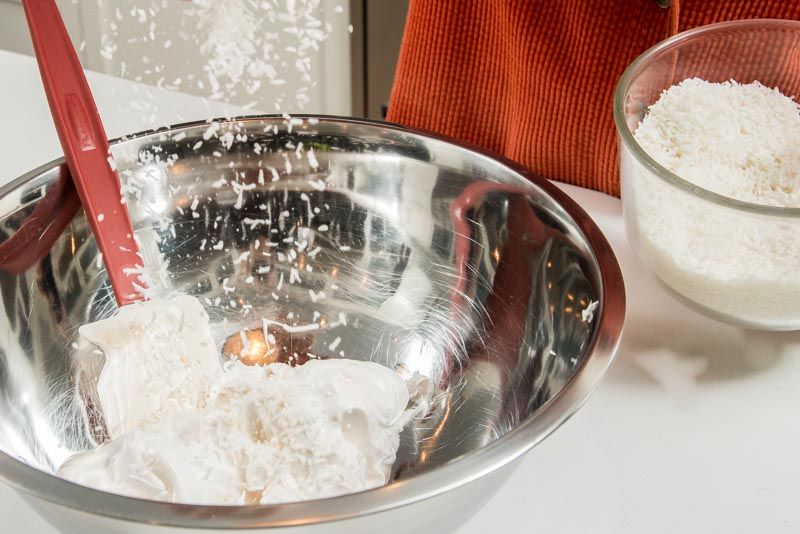
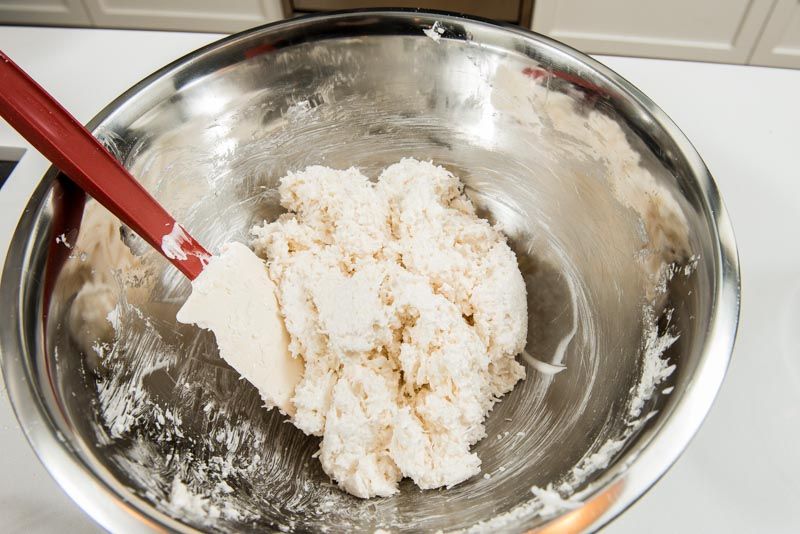
- With a #40 scoop, portion out the coconut macaroon batter, 12 up on a tray.
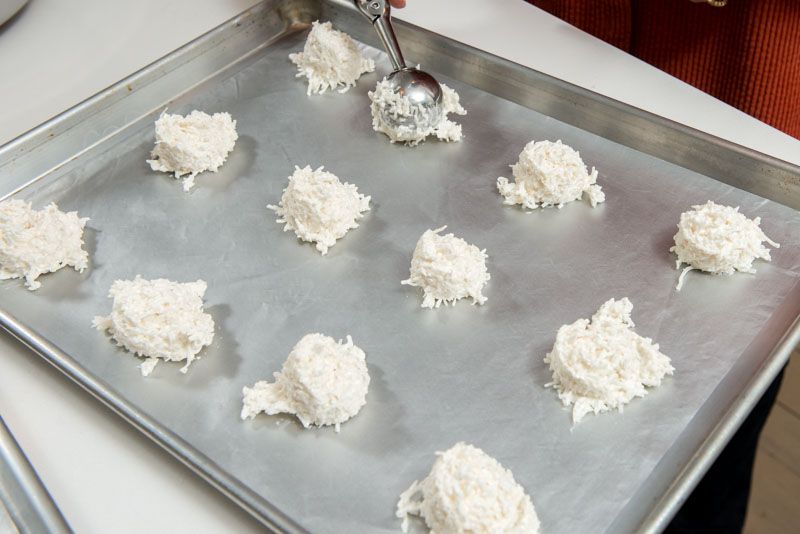
- Shape the macaroons in an oval shape. If you have an oval cookie cutter, use it to help you shape the macaroons. Moisten your hands with a little water to help prevent sticking. Don’t compact the batter too much or it will be difficult to pipe the lemon custard.
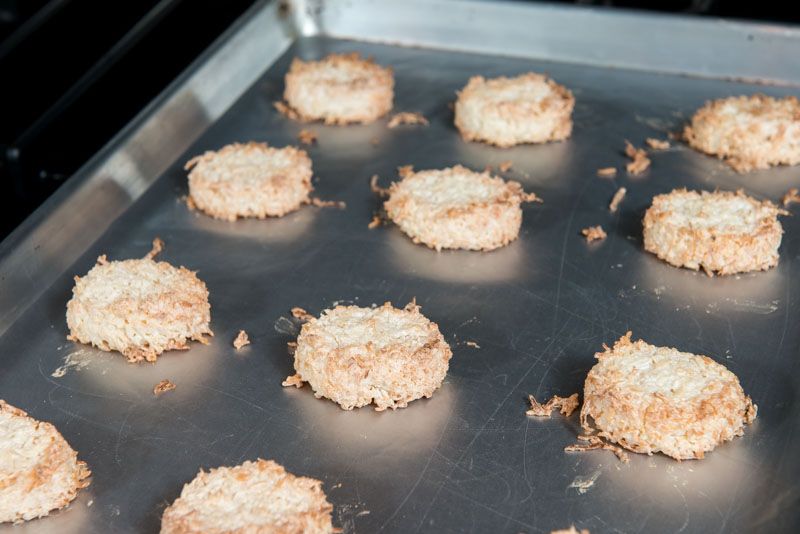
Bake the Cookies at 350F for 10 minutes
- In a 350F oven, bake the macaroons for 10 minutes until set.
- Slide a second baking sheet underneath the first to prevent browning the bottoms of the macaroons. Bake for another 10 minutes until golden brown.
Final Assembly
- While the macaroons are still warm, close up any cracks that might have appeared while baking and wedge a skewer from the side of the macaroon deep into the center. This will be the space the lemon custard will occupy. Let cool.
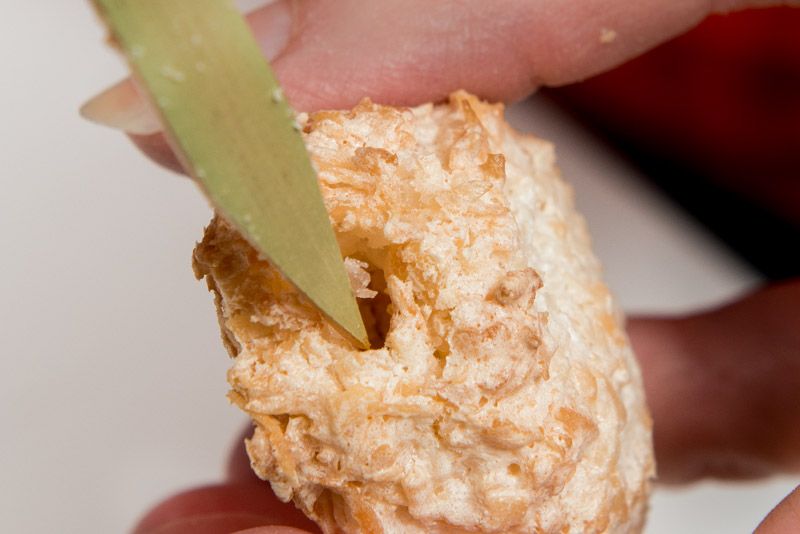
- While the macaroons are cooling, spoon a little lemon custard into a small pastry bag with a Boquilla pastry tip.
- Gently insert the tip into the pre-made crevice and pipe the lemon custard until it’s completely full and oozing. Repeat with all the macaroons.
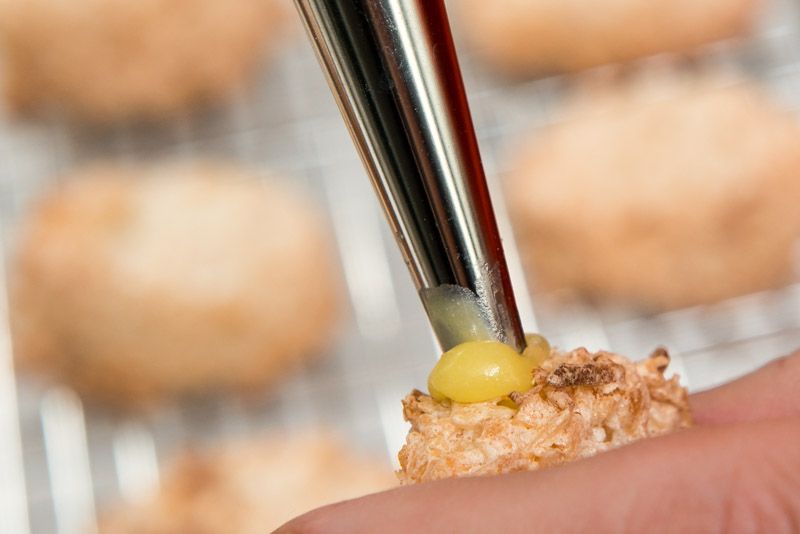
- When ready to eat, break them in half and watch the lemon custard ooze as though it was an egg yolk.
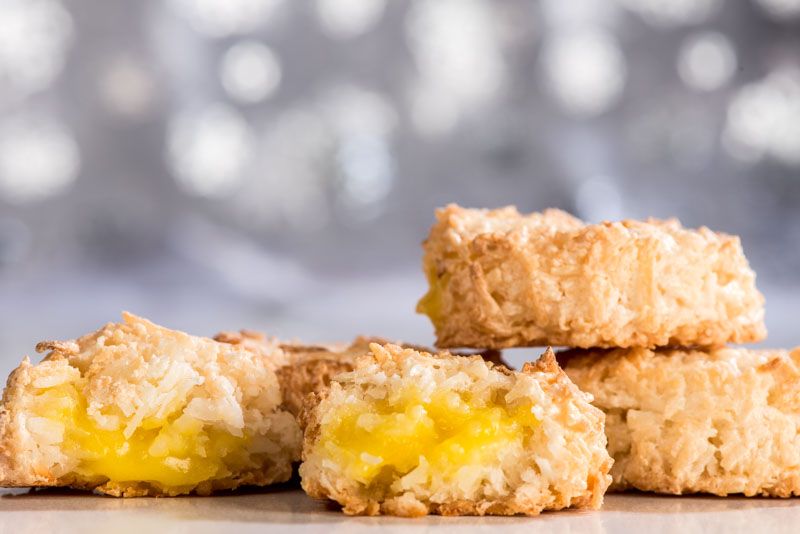
Note on Shelf Life
- These macaroons will last quite a while at room temperature, but over time the lemon custard will be absorbed into the coconut. It will still taste delicious, but will look more like a hard boiled egg, rather than a soft boiled egg.
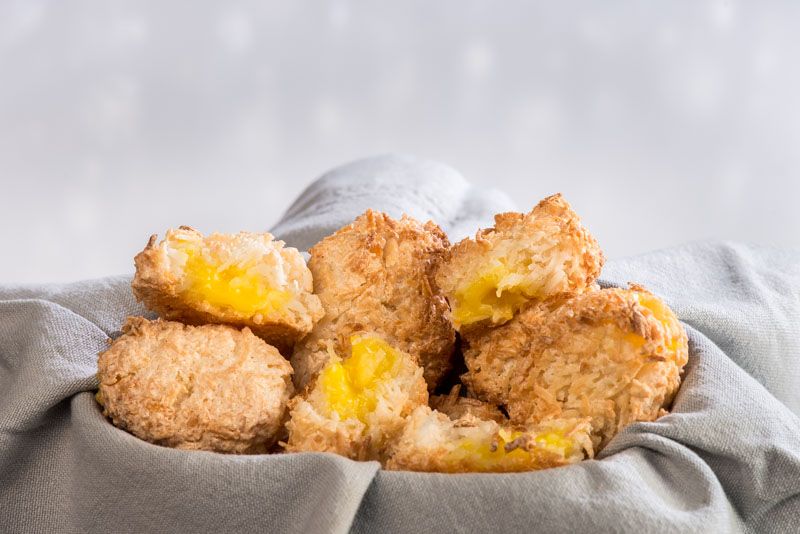
- Labels
- Citrus,
- Gluten Free
- Tags
- Coconut,
- Gluten Free,
- Lemon
